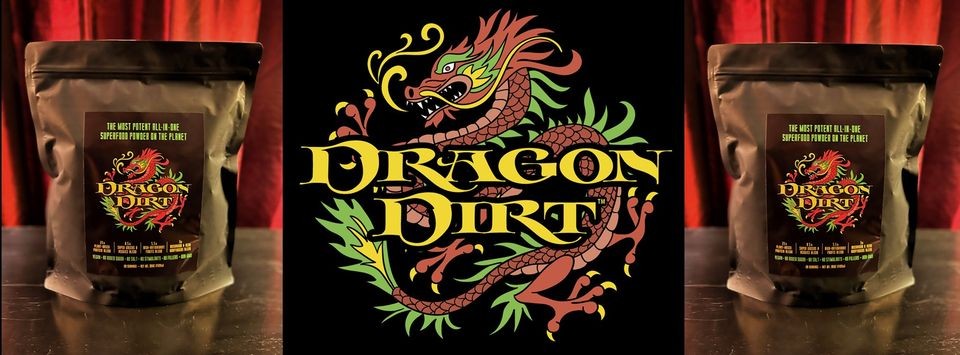The Bobby Rock Newsletter #106 (9-6-23) - The Story of Alphabet Drumming
The Bobby Rock Newsletter #106 (9-6-23) - The Story of Alphabet Drumming
|
To sign up for this Newsletter and/or to scope back issues, click HERE.
|
Hey Everyone -
Back in the LA groove for a hot second this week, before heading to Minnesota for a show this weekend. From there, the rest of September is pretty packed... which is fine by me. Tis the (touring) season!
This week, we have an extra stout edition for you, featuring a long-overdue, detailed documentation of a "sacred" creative project that has occupied a ton of my mental and creative bandwidth through the years. So lend me your ears (and eyes) and let's dive right into it:
In This Issue:
-
To Master it... Measure It!: If you want to improve on something—anything, in fact—figure out how to measure it...
-
A Special B-Day Shout-Out: ...to one of the world's most notorious road dogs! Happy (landmark!) Birthday to my main man... The Cub!!!
-
Alphabet Drumming: Pounding out words and phrases on a giant drum kit that doubles as a sort of percussive "typewriter" might seem a bit unusual. But I absolutely love the concept, continue to find it both exhilarating and challenging to execute, and still get a kick out of how seamlessly the written word tends to translate into cool and unique drumming ideas. So... finally, here's the painstakingly detailed backstory—with plenty of pics and vids—all in one place. Note: This is really more of an extended blog post-sized feature and probably way too long for our Newsletter format here, but... that's never stopped us before! Enjoy...
+++++++
This weekend, with Lita Ford...

Let's rock it!
_______________
To Master It... Measure It!

“You can't improve what you don't measure.”
This is one version of a quote often credited to business giant, Peter Drucker. It underscores the importance of measuring our results, progress, losses, and gains so we can learn precisely how to keep improving in areas of life that are important to us. Often, whenever we are struggling with something (weight loss, financial concerns, etc.), we take comfort in not measuring our results—or not looking at the numbers—as an act of sparing ourselves the full weight of the painful reality at hand.
"Man, I don't even want to look at my bank balance right now," one might say if finances are rough. (A personal favorite through the years!) Or, "I don't want to step on a scale right now.... it will be too depressing," one who is struggling with weight loss might say. It's the opposite of measurement; it's an ignorance-is-bliss form of denial that, certainly, we can all relate to.
Conversely, though, folks who consistently do well with their finances are intimately familiar with account balances and the measurement of all kinds of metrics concerning their financial life: day-to-day P&Ls, investments, retirement funds, etc. And I know for me, I do best with my fitness and training when I'm keeping detailed journals of my progress through some combination of the following metrics: sets and reps of my various lifting routines, weekly road miles, daily nutritional intake, bodyweight fluctuations, hours of sleep per night, etc. Same with my writing and drumming. Daily word counts as a writer get projects completed (something easy to measure!), and a weekly-hours count for my practicing yields quantifiable progress with new things I'm working on—or even with just maintaining a "top-of-my-game" state of chops. Either of these is measurable in my work.
"The Numbers Don't Lie"
Virtually any form of progress can and should be measured by numbers... even when the results are less numbers-centric. This will be obvious if, for instance, you are trying to grow your business and are looking to monthly or annual profits as a barometer... or you are trying to improve your running or cycling speed and are keeping track of your training splits. But even if the results are more subjective—like measuring your progress as a songwriter or web designer—you can also keep track of the various metrics involved there (number of quality new songs written per week, new web clients added per month, etc.) as a measurable indicator of progress. Without some kind of hardcore metrics, it's tough to measure progress with reliability and consistency.
The "Seinfeld" Measurement
Comedian Jerry Seinfeld famously revealed what he used to do to create more material. He would take a wall calendar and X-out each day that he wrote a new joke. The goal? To create a "chain" of Xs on the calendar... and then to not break the chain. In this way, he had a way of measuring progress: to plainly see on a calendar how many days in a row he had maintained an active streak of creating new material.
We can do this for our own pursuits, as well. And at the end of each month, when you take stock of (hopefully) how few empty squares are on the calendar, you, too, will have some quantifiable metrics to evaluate your progress. The game? Don't break the chain. And if you do, I say, definitely don't miss two days in a row!
+++++++
So what's important to you and how can you measure it? Is it a daily or weekly tally of time with an activity? Is it more about measuring quantifiable results or numbers in something? How can progress be measured in areas of life that are important to you?
And remember: If you can measure it, you can master it...
_____________________________
A Special Birthday Shout-Out...

A big (Sept 4) Happy Birthday to this ol’ road dawg right here: The infamous Cubby! The Cub-Man! The Cubster! (AKA Michael Hubschmitt.)
My long-time drum tech since 1988, this bad-ass has done virtually every major tour (and many of the recordings) I’ve done up until his “semi-retirement” from the road a few years ago… including over 900+ drum clinics around North America throughout the 90s. These days, Cubby remains in the trenches with cartage, stage production, and even some recording. He is an industry lifer!
Cubby is also, of course, a loyal, life-long friend and brother. There is only ONE of this guy, and he is truly loved and revered by all who know him. Long live the motherfuckin’ Cub!!!!
Happy Birthday, Big Man! We love you…
_____________________________
The What, Why, and How of Alphabet Drumming™?
What if I designated a letter of the alphabet to 26 different drums, and then created a new language of drumming by "dryping" (drumming + typing) words or phrases?
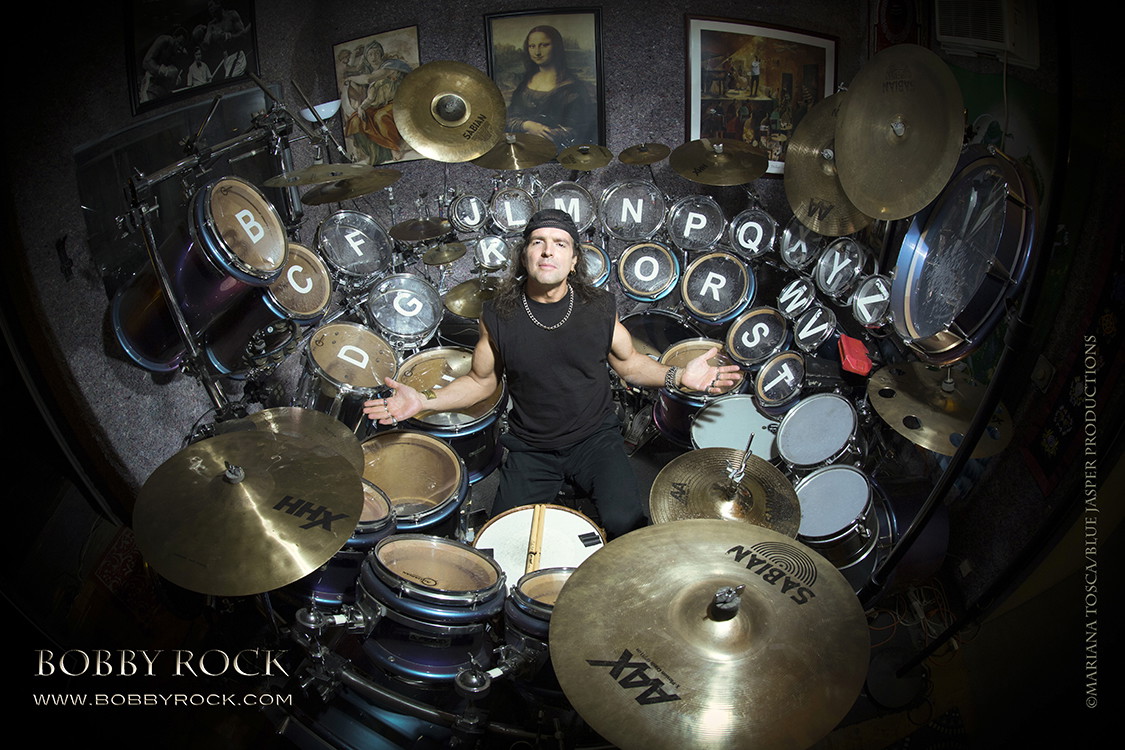
You have likely seen a photo or vid of me in the middle of a huge set of drums, many of which feature a letter of the alphabet displayed on the head. Well, it was recently pointed out to me that, with the exception of a few Newsletter or social posts, and a few buried mentionings on my blog and website, there is really no easily accessible place of detailed explanation or sampling of the whole "Alphabet Drumming" concept, which I've been kicking around now for well over a decade. So, I would like to offer that here, then migrate it over to the blog... just to finally give it its due coverage.
+++++++
The Birth of Alphabet Drumming™
The year was 2008. I was "temporarily" living in a two-room office/practice space at an industrial complex in North Hollywood, CA. On one side of the space was a gigantic 26-piece drum kit; on the other was my desk, multiple shelves of books, a couch where I slept, and a few other food/clothing essentials (small refrigerator, blender, suitcase, etc.). These were barren, yet highly-creative, times.
One night, I was working on a new book, contemplating elevated creative processes and pondering how we humans expand, evolve, and get better. It was pushing 4:00 AM, and my mind was veering off into some strange, sleep-deprived territories, as I sat at the laptop, pecking away. I was considering the key differences between the “right” and “left” sides of the brain, and how so many of our greatest thinkers and artists showed tremendous development and engagement of both sides (because this is what we practice room-dwellers who don't drink or do drugs think about!).
I recalled that left-brain function has to do with tangible, structured things like logic, letters, words, numbers, analysis, lists, form, and language. Right-brain function is more abstract and creative-oriented, dealing with color, music, rhythm, imagination, daydreaming, space, and dimension. And that, to reach our true intellectual and creative potential, we need to develop and condition both aspects of the brain, even if our primary expression is based largely toward the left (as a scientist) or toward the right (as an artist). I figured that, despite the extreme left-brain elements of drumming, it was ultimately a right-brain endeavor, because it involves music, rhythm, conveying a feeling, and so forth. So... my question of the night was, How could I integrate more left-brain into my practice or process?
And then, in an epiphanic flash, it hit me: I am a drummer. I am a writer. I have precisely 26 drums and… coincidentally, there are 26 letters in the alphabet. What if assigned a different letter to each one of my drums, then "spelled out" various words or phrases, in rhythm, creating a unique language of patterns that could, quite literally, expand my drumming vocabulary?
Whoa. Interesting. But why?
Because to construct musical riffs and patterns in accordance with a writing modality would require a radically unconventional approach to drumming. How might this expand my technique, as well as my creative pool of ideas? What might these various words or phrases sound like? And how accomplished would I have to become in these new techniques to fluidly pull this off?
Obviously, this would be a fairly mechanical idea at first. But it would no doubt lead to the creation of a number of different note patterns, groupings, and combinations I would have never stumbled across before. And once I established a flow with these new "vocabulary words," so to speak, then I could bring more right-brain musicality and artistry into the ultimate execution of them.
My dreamy mind was suddenly jolted into the moment, as if a cold bucket of water had been poured over my head.
And so the journey began...
+++++++
A Starting Point
Integrating the word D-R-U-M-M-I-N-G into a groove was one of the first ideas I ever tried (although I didn't film it until years later):
+++++++
Lab Work:
Project Alphabet Drumming
The first two things I realized when I actually took a shot at assigning letters to my drums were:
1. I needed to relegate the letters only to drums I hit by hand (as opposed to my various kick drums), so my feet would be free to do things independently from the alphabet stuff, and;
2. All drums with letters needed to be reconfigured and mounted together as close as I could get 'em, so I could more efficiently "spell out" the words. Some of those extreme left-to-extreme right (or vice-versa) leaps to reach letters made it nearly impossible to get any real fluidity happening when dryping certain words.
Of course, I still wanted all those other various sound sources to the extreme left and right of me. But this meant I would have to fill out sections of the kit with, essentially, an extra row or two of drums so the entire alphabet could be contained within a 180-degree sphere.
This led to my initial version of the setup, which looked like this. (Notice I didn't initially label which letters were assigned to which drums. More on that in a moment):

And here's a vid I shot using this setup. Oddly, this is one of the only vids I could find with this configuration of the Alphabet Kit (which I typically refer to as the Alpha Kit). I did a series of 3 or 4 takes of playing just the "timbale" side of the kit on this original configuration before the 360-degree version. I posted one or two of these on YouTube with not much thought... but would never wind up posting another playing vid from the Alpha Kit for nearly a decade! Not sure why.
But this setup was just the beginning of where it would wind up.
+++++++
A New Twist on Sabbath
This groove is from my instrumental version of Black Sabbath’s “Supernaut,” and it is indicative of how I usually stumble into new ideas on the Alpha Kit. In this case, I was jamming around with a Latin-linear funk-rock groove with the cowbell, thinking about the song… and the band… and I thought, Wow… Sabbath… Supernaut…. cool... Hey, wait a minute: S-A-B-B-A-T-H. I played it. It sounded interesting. Then I incorporated it into the pattern. Same with S-U-P-E-R-N-A-U-T. It had a cool swing about it, so I squeezed it in, as well. It took a little wedging at first, but then, the two words added an interesting call-and-response kind of feel to this revised pattern. It sounded really musical to me, so I kept it.
Here is the original notation:
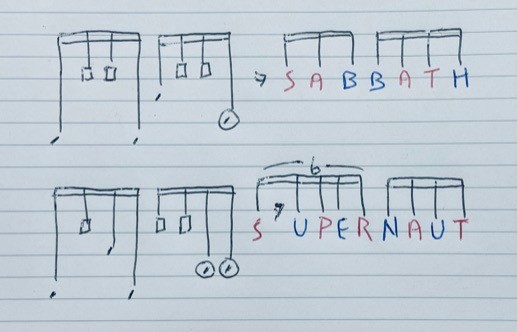
Note: Letter color designates sticking—Red = right hand; Blue = left hand. Meanwhile, the circled noteheads are viewed as additional sound sources, as opposed to additional letters: in this case, a "timbale" and a floor tom.
+++++++
Going 360
The final big step in the basic evolution of the Alpha Kit was adding a whole other front section so the kit would be 360 degrees. Why?
1) At the time, I figured if I ever played the kit live, I wouldn't want my back to the audience the whole show, and;
2) I figured having a more conventional set-up (the front-facing portion) would give me a chance to play more conventionally when appropriate, so the kit would represent the proverbial best of both worlds.
Here is one of the earlier shots of this transformation:
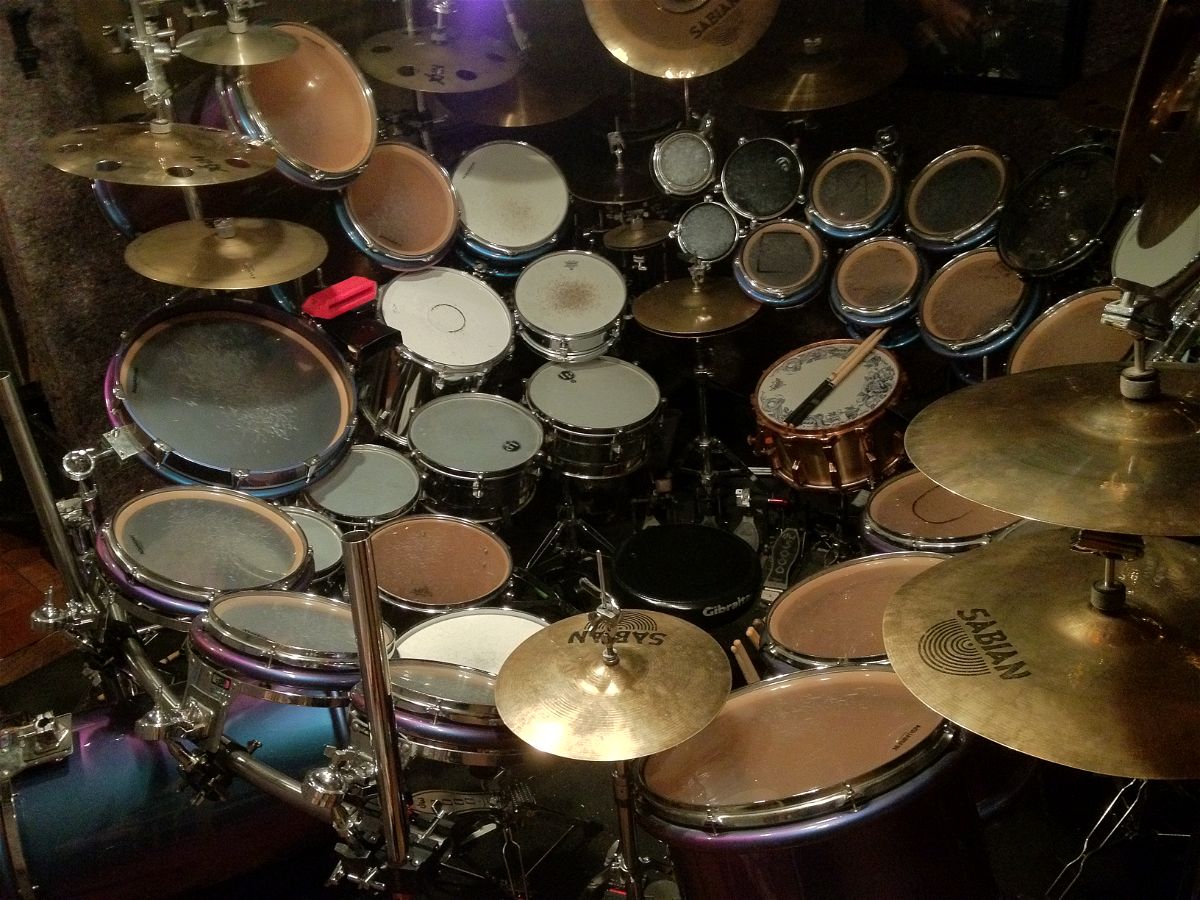
And here's one of the only vids I have shortly after adding the front half... although I'm mainly just jamming around on the Alpha side of the kit, exploring ideas.
+++++++
About the Letters and Set-Up
As for how I chose to arrange the letters on the drums...
Why not just approximate a computer keyboard with the set-up?
This concept was never about the mere novelty of trying to create a drum set-up that replicated a giant computer keyboard, and then, essentially, engaging in some kind of typing-with-drum-sticks routine. Besides, trying to replicate the traditional "QWERTY" keyboard layout with a drum kit would be a logistical nightmare, in terms of maintaining any kind of efficient drumming ergonomics. Instead, this concept was always about playing a kit that was set up to my liking, and then assigning letters according to that set-up, so I could aspire to play unusual things as I spelled out words in rhythm. This way, I could add these alphabet drumming techniques to my current, expanding arsenal—and that was the point: To evolve and expand... to play wildly different things than I otherwise would've (or could've) via traditional/conventional means.
And so, I ultimately chose to lay out the letters in a simple 1/2-and-1/2 kind of format: The first half of the alphabet is basically arranged in order from B to M (snare drum is A) on the left hemisphere of the kit, and N to Z on the right hemisphere of the kit. Also, notice that the five vowels (A, E, I, O, U) are conveniently arranged closest to me, in a circular pattern from the snare to my first floor tom. This was also by design, as I view vowels as "linking" letters to consonants.
To Label the Drums... or Not
At first, I was just going to memorize which letter went with each drum. But not only was this impossibly arduous, it also took away any prayer of contextualizing what I was playing for the viewer. So, as of February 2014, I started adding alphabet decals on the underside of each head. Additionally, the split-second eye-hand connection of being able to read each letter proved to be critical in playing certain alphabet drumming phrases with any degree of speed.
Here are two initial, back-to-back Instagram posts documenting this new development as it went down (with an exceedingly modest number of likes!):

+++++++
Speaking of Rumi...
Here's a basic thematic pattern where I drype some words of the legendary Sufi poet, Rumi. This simple two-bar phrase is part of a larger solo piece I’ve been working on, but I think it’s fascinating how Rumi's words transpose into drumming that sounds so… well… poetic!
My original notation:

+++++++
Here's where we eventually wound up with regard to something of a "final" setup:
About the Drums
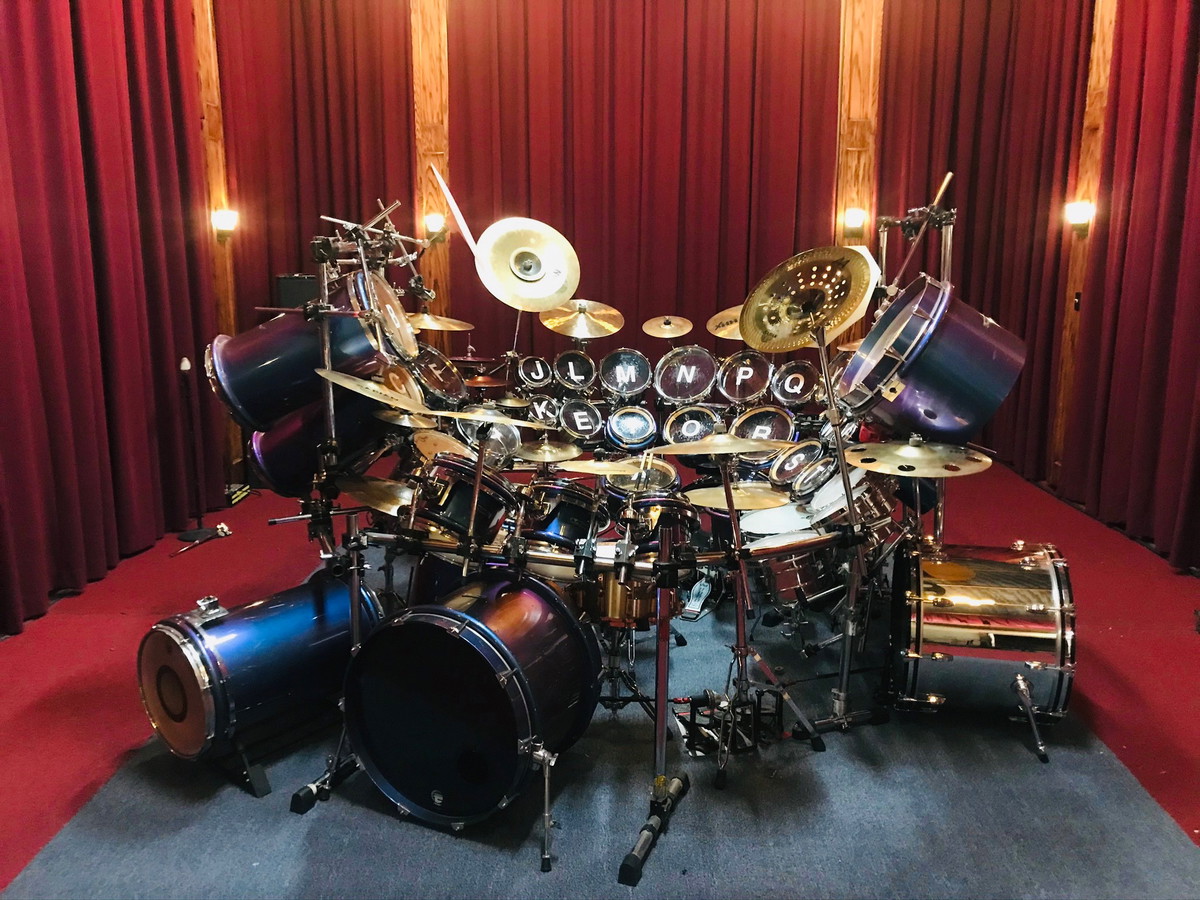
This beautiful monstrosity—as it exists in this photo— has been my primary practice room/solo project drum set for more years now than I can recall. A big chunk of the kit is my original Radial Bridge drum set that Steven Volpp and the Peavey gang built for me back in ’99. Then, once I began to develop the Alphabet Drumming™ concept (as described here), I began to bring in a mish-mash of other drums, and the kit expanded into its present 360-degree design so I can face forward or backward, as it's essentially two giant kits melded together.
Because I’m more of an accumulator than a collector, I had amassed a wide variety of drums and cymbals in storage near my practice room. And as my vision for this kit expanded through the years, each new piece was brought in as somewhat of a functional placeholder for what would surely, one day, be some mammoth new custom-built drum kit, sparkly and pristine, with its perfect maple shells and glistening brass and chrome. After all, this was just the 1.0 Frankenstein version of the Alpha Kit, right?
But then, somewhere along the way, after countless hours of playing this kit and listening to its glorious tones reverberate around the woodshed, something unexpected happened: the “Frankenstein" nature of the kit became its own unique thing—its own twisted choir of percussion voices—and it simply sounded like no other set of drums I’ve ever heard. In other words, the unorthodox configurations and unconventional drum and cymbal groupings created their own original, collective sound. And I knew that, at least for the foreseeable future, this would be my primary solo kit… just as it is: all 40 drums, 30 cymbals, and 10 foot pedals of it.
Here's a walk-around tour of the Alpha Kit in its most current configuration:
+++++++
The Fine Line Between Music and Performance Art
When the idea of Alphabet Drumming™ first hit me, I thought it was so unique, I began to envision this grandiose, mega-production concept. I saw a huge screen above me and this massive rig, in some theater setting, with each drum triggering its letter onto the screen as I hit it so the audience could read what I was playing as I was playing it. In my 2015 book, Zentauria, I even wrote about this idea in the context of a drum solo excerpt (minus all of the big screen technology).
But here's the thing: I quickly figured out that playing these long passages of text, for the most part, best translated when the listener/viewer could read what I was spelling-out. And at that point, I believe we are venturing into more of a performance art vibe, as opposed to something purely musical.
Will I ever pursue the above grandiose idea? Probably. But so far, I have preferred to focus on chunks of text (i.e. "cool new ideas") in tandem with my other more conventional approaches... which is why most of the examples I've actually documented are on the shorter side... so far! (Although I must say, I've worked out certain longer pieces of prose and literature through the years that clearly hold up on their own as riveting solo statements.)
_______________
A Few More Samples For Your Viewing Pleasure!
Here are a few more clips covering different aspects of the Alpha Kit in action:
"I Have a Dream"
Here's an example of an iconic phrase, "played" via Alphabet Drumming.
On Dr. King’s birthday one year, I was doodling around in the practice room and started spelling out—in rhythm—the tail end of his infamous "I Have a Dream” speech. Eventually, I made a quick vid of it. Here it is:
Here are my original notes, scribbled on the back of some random index card:
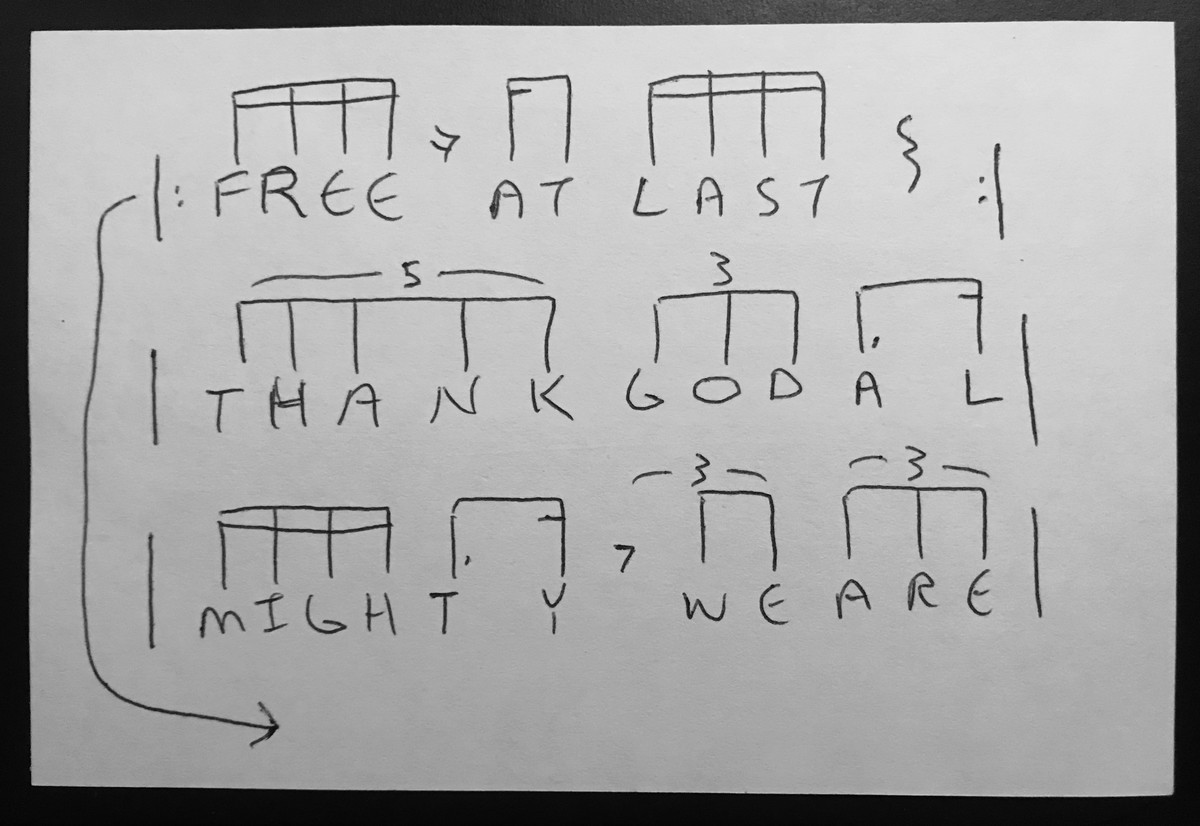
+++++++
"I Wanna Rock"
This is another practice room video of initially working out this Alphabet Drumming™ groove for the chorus of Twisted's "I Wanna Rock." (I was looking to include a funky instrumental interlude of this tune on an upcoming recording.) Once again, this vid was never intended for public consumption... just a pre-production vid for my own reference (hence the typical self-scolding at the tail end!).
You’ll also notice that, at times, I will hit other lettered drums here or there—typically at the end of a phrase—to fill in a groove. But I’m viewing them more as a supporting sound source, as opposed to a letter integral to the spelling of something. After all, the Alphabet Drumming™ concept is just a means to a greater end: different-sounding shit!
PS. And yes, the kick drums were always meant to be used for fill-in notes (or ostinatos in a solo situation), since they don’t represent any letters. This was also by design…
+++++++
Obviously, I'm not always looking to "spell-out" words from the Alpha side of the kit. There is an inspiring collection of sound sources over there that can be played with a more conventional approach... even though things don't tend to sound very conventional (given the unusual combinations of drums at hand). Here are a few examples:
"Sounds for Days..."
Here's yet another practice room vid that was never intended for public consumption. I'm working on some longer-form phrasing ideas, creating different rhythmic/melodic combinations around the alphabet side of the kit. Again, in these instances, I'm not thinking about spelling... only about the unique collection of sound sources in front of me!
+++++++
"Sweeps"
I refer to this particular thing as "sweeps"... which are, in my mind, a drummer's version of those dense clusters of notes you hear on guitar or saxophone that sound cool when played really fast. To me, they have more of a wall-of-sound "color" kind of vibe, which is nice to have in the toolbox for special solo riff or drum fill occasions. Here's where it helps to have a shit-load of sound sources!
+++++++
"Bending Time"
Here's a little practice room snippet from a few years back, where I'm working on some odd-note phrasings. The time remains "in 4," but I'm experimenting mainly with some 5-note groupings to create some tension (with only a minor "self-scolding" at the end!)
Here's a little practice room snippet from a few years back, where I'm working on some odd-note phrasings. The time remains "in 4," but I'm experimenting mainly with some 5-note groupings to create some tension (with only a minor "self-scolding" at the end!)
+++++++
"Multi-Voice Groovin'"
And from the front side of the kit, here's a little multi-voice improvisation where we keep a very basic kick/snare groove chugging along, while we integrate multi hats and cowbells.
And from the front side of the kit, here's a little multi-voice improvisation where we keep a very basic kick/snare groove chugging along, while we integrate multi hats and cowbells.
+++++++
If you have made it all the way here to the end... I'm impressed! Thank you, and good night!
BR
_____________________________
To sign up for this Newsletter and/or to scope back issues, click HERE.
_______________
Thanks again, everybody. Connect soon!
Until then,
BR
_______________
|
For Your Quick Reference: My main website at www.bobbyrock.com is constantly updated with cool new stuff. Be sure and take a moment to sign up in the upper right-hand corner of any page on the site. It only takes a minute. This will give you a much more customized experience, and also grant you access to various members-only areas, events, etc. Newsletter Archives: Scope all the back issues here. There is even a Table of Contents reference so you grab an "at-a-glance" view of what's in each issue. News Feed: Stay in touch! Think of this as Facebook and Instagram rolled into one location, plus extra posts exclusive to the site. The Bobby Rock Store: Books, Music, BR drumsticks (stage-played and brand new), T-shirts, Signed 8x10s, Dragon Dirt and more... Dragon Dirt: My signature, custom superfood powder. Scope the site for tons of info! |
_______________

